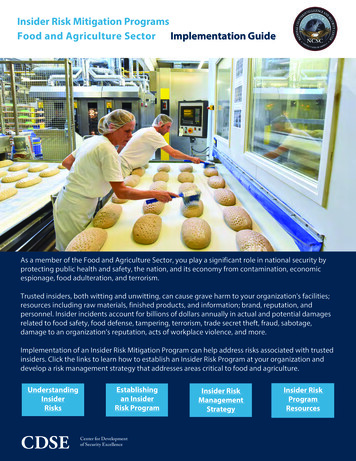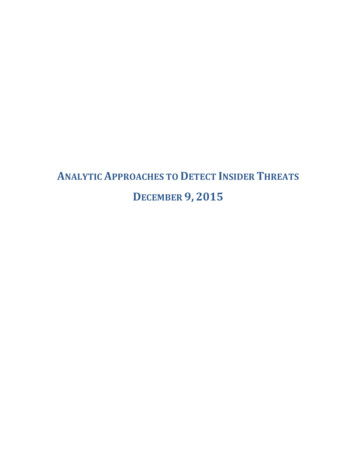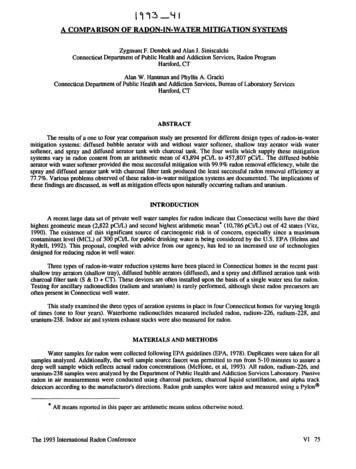
Transcription
Insider Risk Mitigation ProgramsFood and Agriculture Sector Implementation GuideAs a member of the Food and Agriculture Sector, you play a significant role in national security byprotecting public health and safety, the nation, and its economy from contamination, economicespionage, food adulteration, and terrorism.Trusted insiders, both witting and unwitting, can cause grave harm to your organization's facilities;resources including raw materials, finished products, and information; brand, reputation, andpersonnel. Insider incidents account for billions of dollars annually in actual and potential damagesrelated to food safety, food defense, tampering, terrorism, trade secret theft, fraud, sabotage,damage to an organization’s reputation, acts of workplace violence, and more.Implementation of an Insider Risk Mitigation Program can help address risks associated with trustedinsiders. Click the links to learn how to establish an Insider Risk Program at your organization anddevelop a risk management strategy that addresses areas critical to food and n InsiderRisk ProgramCenter for Developmentof Security ExcellenceInsider RiskManagementStrategyInsider RiskProgramResources1
HAT IS INSIDER THREAT?An insider threat is anyone with authorized access who uses that access towittingly or unwittingly harm the organization or its resources. Insiders caninclude employees, vendors, partners, suppliers and others that you provideaccess to your facilities and/or information. Most insider threats exhibit riskybehavior prior to committing negative workplace events. If identified early, manythreats can be mitigated before harm to the organization occurs. Learn moreabout insider risk indicators and find free training and awareness materials here.WHAT THREATS DO INSIDERS POSE TO FOOD AND AGRICULTURE?Numerous threats have the potential to cause major disruption in food andagriculture operations and to harm public health and safety. These includemalicious acts committed by insiders such as deliberate food adulteration, fraud,theft, sabotage, and workplace violence. Unwitting insiders may inadvertentlydisclose proprietary or sensitive information, impact food safety through negligentactions, or unknowingly download malware or facilitate other cybersecurity events.The food and agriculture sector is also vulnerable to transportation and supplychain failures, contamination, and threats to industrial control systems or othertechnical systems. Unmitigated insider risk is likely to increase thesevulnerabilities. Click here to learn about real world insider incidents in the foodand agriculture sector.WHY ESTABLISH AN INSIDER RISK MITIGATION PROGRAM?Insider Risk Mitigation Programs are designed to detect, deter, and mitigate therisks associated with trusted insiders. Multidisciplinary teams or “hubs” arecomprised of security, human resources, cyber, legal and other professionals such asquality control, facilities, and employee health and safety from throughout yourorganization. These teams work together to gather, integrate, and assessinformation indicative of potential risk and determine appropriate mitigationresponse options on a case by case basis. Most of these responses allow individualsto retain their position and receive assistance while protecting the organization andits assets. Insider Risk Programs also protect the privacy of the workforce whilereducing potential harm to the organization. See the Establishing an Insider RiskProgram section to learn more.HOW CAN MY ORGANIZATION MANAGE INSIDER RISK?Effective Insider Risk Programs deploy risk management strategies that identify theassets or resources to be protected, identify potential threats, determinevulnerabilities, assess risk and deploy countermeasures to mitigate risk. Manycountermeasures are no or low cost to the organization and include training andawareness, clear reporting policies, managing organizational trust, and enhancedsecurity procedures. Review the Insider Risk Management Strategy to learn more.Food industryIndustrial ControlSystems may bedistinctlyvulnerable to cyberInsider Threats*"Adulterating More Than Food:The Cyber Risk to Food Processingand Manufacturing," by theUniversity of Minnesota's FoodProtection and Defense Instituteillustrates the mountingcybersecurity risk facing the foodindustry and specific industrialcontrol system vulnerabilitiesrelated to networks, USB drives,and aging systems reliant onsingle points of failure. Thesesystems are particularlysusceptible to actions bymalicious insiders. Food industryICS are also at risk fromunintentional actions andnegligence on the part ofemployees. Read the full reporthere.WHAT RESOURCES ARE AVAILABLE TO ME?The US Department of Agriculture, Food and Drug Administration, DefenseCounterintelligence and Security Agency, Department of Homeland Security,National Insider Threat Task Force, Federal Bureau of Investigation, and theNational Counterintelligence and Security Center have numerous free resources.View Insider Risk Resources to learn more.2RETURN TO MAIN PAGE
UNDERSTANDINGESTABLISHING ANINSIDERINSIDERRISKRISK PROGRAMInn GuideSETTING UP YOUR PROGRAM An Insider Risk Mitigation Program is a multi-disciplinary activity or "hub" established by an organization togather, monitor, and assess information for insider risk detection and mitigation. Program personnel analyzeinformation and activity indicative of insider risk and determine appropriate mitigation response options up to andincluding referral to the appropriate officials for investigation and/or resolution. Best practices encourage the InsiderRisk Program to include a multidisciplinary team consisting of Legal Counsel, Security, Cybersecurity, Mental Healthand Behavioral Science, and Human Resources or Human Capital disciplines to effectively counter insider risks inyour organization. The exact makeup of your Insider Risk Program will depend on the size and complexity of yourorganization. Consult the Quick Start Guide for step-by-step recommendations. Insider Risk Mitgation Programs take proactive measures to deter, detect, mitigate, and report the threatsassociated with trusted insiders. The program identifies anomalous behaviors that may indicate an individual poses arisk. Early identification allows Insider Risk Program personnel to focus on an individual’s issues of concern orstressors and deploy appropriate mitigation responses. When necessary, the team shares relevant information fromeach discipline with organizational leadership to facilitate timely, informed decision-making and reports informationoutside the organization as required. The first step in establishing your program is to identify the program office and leadership. You must determinehow the team will be structured and where it will be located. Does your organization have the ability to housethe team in a single location? Or, are the team members geographically separated and must rely on virtualcommunications to conduct operations? Your organization should select an Insider Risk Mitigation ProgramSenior Leader or program manager that oversees day-to-day operations. They will work with the organization’ssenior leadership to determine resource and staffing needs. You should establish rules for how the Insider Risk Mitigation Program will operate within your organization. Aspart of rule and policy development, the Insider Risk Program should also identify practices for safeguarding sensitivepersonnel information along with consequences for violations of internal rules committed by Insider Risk Programteam members. Insider Risk team members must maintain standards of professional conduct like any other personnel.However, because you’re dealing with extremely sensitive information it’s important that you clarify theseresponsibilities up front. A sample Insider Risk Mitigation Program Plan is included in the Resources section. You should also ensure that Insider Risk Mitigation Program personnel are properly trained to conduct theirduties. Insider Risk Program personnel must be able to appropriately respond to incident reporting, protect privacy andcivil liberties, support mitigation options, and refer matters as required. Many free training options exist. Consult theResources section for more information.RETURN TO MAIN PAGE3
UNDERSTANDINGESTABLISHING ANINSIDERINSIDERRISKRISK PROGRAM (Cont.)Inn GuideDETECTING AND DETERRING INSIDER THREATS The purpose of an Insider Risk Mitigation Program is toproactively deter, detect, mitigate, and report threatsassociated with trusted insiders. These actions make upyour daily operations. Insider Risk Programs detectindividuals at risk of becoming insider threats byidentifying potential risk indicators. These observableand reportable behaviors or activities may indicate anindividual is at greater risk of becoming a threat. InsiderRisk Programs deter potential insider threats byinstituting appropriate security countermeasures,including awareness programs. Training and Awareness Programs. You must train andexercise your workforce to recognize and report potentialrisk indicators. It is a best practice to require personnelto complete initial and annual Insider Risk Awarenesstraining. You can also maintain workforce awarenessof insider risks and employee reporting responsibilitiesyear round by instituting a vigilance campaign. InsiderRisk Programs can also conduct internal evaluations.These are small exercises used to test your workforce’sknowledge of insider risk indicators and reportingrequirements. These exercises do not have to beelaborate but should help you gauge the effectivenessof your program. You may use information from these evaluations to adjust your training and awareness program toensure effectiveness. See the Resources section for access to free training and awareness materials. Reporting Procedures. Your Insider Risk Program must establish reporting procedures for the general workforce.Those that witness potential indicators should know exactly when, where, and how they can report the information.Prepare procedures for “walk-ins” or those that may want to report their information face to face. Procedures shouldalso include hotlines or dedicated email addresses. Consider providing means for anonymous reporting. Individualsshould be encouraged to self-report any issues they may be experiencing. One of the goals of an Insider Risk Programis to deter adverse actions by pointing those asking for assistance to resources that can help them. The challenge is tohave people see the Insider Risk Program as a resource rather than a punitive element. You can build this rapport byinforming the workforce of your program, the mission, and its goals; by respecting privacy and civil liberties, and bydeploying appropriate insider risk mitigation responses. Organizational Justice. As a best practice, Insider Risk Programs should consider the concept of organizationaljustice. Organizational justice refers to employee perceptions of fairness in the workplace. Labor relations can have anoverall effect on the number of insider threat incidents you see. The worse the labor relations are, the more incidentsyou may encounter. Counterproductive workplace environments have consequences that can lead to disgruntlement.Organizational leadership that develops a positive workplace environment keeps the workforce engaged andproductive. This same concept applies to the Insider Risk Program. Ensuring appropriate mitigation response optionsand the protection of privacy and civil liberties in the conduct of your duties will minimize negative outcomes frommaladaptive responses. Being responsive to workforce concerns is a great way to build rapport with personnel;encourage future reporting; and ultimately mitigate risk.4RETURN TO MAIN PAGE
UNDERSTANDINGESTABLISHING ANINSIDERINSIDERRISKRISK PROGRAM (Cont.)Inn GuideINSTITUTING USER ACTIVITY MONITORING User Activity Monitoring (UAM) is the technical capability to observe and record the actions and activitiesof an individual operating on your computer networks, in order to detect potential risk indicators and to supportmitigation responses. Logging, monitoring, and auditing of information system activities can lead to early discoveryand mitigation of behavior indicative of insider threat. UAM also plays a key role in prevention, assistance, andresponse to acts of violence. As such UAM development should include consideration of potential acts of violenceagainst organizational resources, including suicidal ideation. Implementation will be specific to your location, but as a best practice your organizations should: Define what will be monitoredIndicate how monitoring will be institutedInform users of monitoring actions via bannersIdentify indicators that require review (e.g., trigger words, activities)Protect user activity monitoring methods and resultsDevelop a process for verification and review of potential issuesEstablish referral and reporting procedures Establishing baseline user behaviors will make deviations or anomalies stand out from normal activities. It will alsohelp determine what your user activity monitoring triggers, also known as internal security controls, should be. Oncea “Normal Activity” baseline is established, internal security controls help us identify deviations. For example, useractivity monitoring could help identify a rash of IT system misuses that suggest an employee needs some retraining.Another example would be access control logs indicating an employee is working irregular hours or has unexplainedabsences from work. User Activity Monitoring can help identify potential risk indicators that can be evaluated duringyour risk management and mitigation process. For more information, access the Insider Threat Indicators in User Activity Monitoring job aid. Now that you’ve established an Insider Risk Mitigation Program, it’s time to employ risk management and mitigationstrategies. Your Insider Risk Program should be able to identify and mitigate many issues before they escalate intonegative behavior and respond appropriately when preventative actions are not feasible. Access the Insider RiskManagement Strategy section to learn more.RETURN TO MAIN PAGE5
UNDERSTANDINGINSIDER RISKINSIDER RISK MANAGEMENTSTRATEGYRISK ANALYSISRisk based analysis allows the Insider Risk Mitigation Program to manage risk in a complex threat environment.The process of identifying assets, assessing threats and vulnerabilities, evaluating risk, and identifyingcountermeasures can help determine the risks most closely associated with trusted insiders in the food andagriculture sector and the best methods to deter and mitigate them. It also allows your organization to differentiatebetween exigent threats to your enterprise and less pressing matters.IDENTIFY CRITICAL ASSETS The most basic function of an Insider Risk Mitigation Program is to protect the assets that are required by law andpolicy (such as those impacting food defense and food safety) and/or that provide your organization with a competitiveadvantage (such as proprietary data or processes). A critical asset can be thought of as something of value that whichif destroyed, altered, or otherwise degraded would impact confidentiality, integrity, or availability and have a severenegative affect on the ability for the organization to support essential missions and business functions. Critical assets can be both physical and logical (i.e. on computers) and can include facilities, systems, equipment,and technology. An often-overlooked aspect of critical assets is intellectual property. This may include proprietarysoftware and product formulas, customer data, schematics, and internal manufacturing and distribution processes. Theorganization must keep a close watch on where assets, including data, are at rest and in transport. Current technologyallows more seamless collaboration than ever, but also allows the organization’s sensitive information to be easilyremoved from the organization. Note that assets may be at risk at any point in your supply chain and third partyvendors and suppliers that are given access to your assets also have the potential to pose insider threats. A complete understanding of critical assets (both physical and logical) is invaluable in defending against attackers whowill often target the organization’s critical assets. The following questions help the organization to identify andprioritize the protection of its critical assets: 6What critical assets do we have?Who has access to these assets?Do we know the current state of each critical asset?Do we understand the importance of each critical asset and explain why it is critical to our organization?Can we prioritize our list of critical assets?Do we have the authority, money, and resources to effectively monitor our critical assets?The role of the program manager is to work across all areas of the organization to answer the questions above.Once those questions are answered within each division, input from senior level management should be obtainedto prioritize protection across the organization. Once critical assets are identified and prioritized, the organization mustidentify those high-risk users who most often interact with the critical systems or data. This will help theorganization to identify the best approaches to successfully identify potential insider risks.RETURN TO MAIN PAGE
UNDERSTANDINGINSIDER RISKINSIDER RISK MANAGEMENTSTRATEGY (Cont.)CONDUCTING A RISK ASSESSMENTThe Risk Management ProcessRisk management is a process that provides a frameworkfor collecting and evaluating information to: Identify assets (identify value of asset) Assess threats (intent and capability of adversaries) Assess vulnerabilities (identification and extent ofvulnerabilities) Assess risk (consider threats in relation to identifiedvulnerabilities) Determine impact of loss, damage, or compromiseof asset Develop countermeasures (security countermeasureoptions that can reduce or mitigate risks cost effectively) Apply countermeasures Monitor and re-evaluateFor More Information on Risk Management click here Once you have identified critical assets, work to assess and analyze threats to, vulnerabilities of, andconsequences of disruption to your organization. Ensure that your assessment considers the physical, cyber, and human elements of security and resilience;supply chain issues; and your interdependence on vendors, partners, and other critical infrastucture sectors. Translate your analysis into actionable countermeasure that can be deployed to reduce or mitigate risks andinform response and recovery actions. Consult the Food and Agriculture Sector-Specific Plan issued by the Department of Homeland Security. Consult the Food Safety Modernization Act final rule on Mitigation Strategies to Protect Food AgainstIntentional Adulteration issued by the Food and Drug Administration for further information onvulnerability assessments. You may also consider implementing the Risk Management Framework (RMF) for information systemswhich can help mitigate risks from cyber attack. More information on RMF is available from the NationalInstitute of Standards and Technology. You can also access free training on the topic here.RETURN TO MAIN PAGE7
UNDERSTANDINGINSIDER RISKINSIDER RISK MANAGEMENTSTRATEGY (Cont.)RISK MITIGATION To be effective, Insider Risk MitigationPrograms must be on the lookout for potentialissues before they pose a threat. In most cases,proactive mitigation responses provide positiveoutcomes for both the organization and theindividual. This allows you to protectinformation, facilities, and personnel, retainvaluable employees, and offers intervention tohelp alleviate the individual’s stressors. Your Insider Risk Mitigation Programs responsesare situationally dependent, but may includerecommendations such as: Suspending access to information Taking personnel actions such ascounseling, referral, or termination Organizational responses that may requirechanges to policy or procedures Increased or additional training Human Resources Insider Risk Mitigation Program team members can assist with counseling referrals or prescribedhuman resource interventions which may be corrective in nature. They deal with Employee Assistance Programs forresources in financial counseling, lending programs, mental health, and other well-being programs. Insider Risk Mitigation Program team members from the various security disciplines, whether cyber, personnel,information, or physical, can assist with mitigation response options such as updating security protocols, adjustingUAM or other inspections, and providing basic security training and awareness to the workforce. Some insiderthreat incidents may warrant external referrals to counterterrorism or law enforcement authorities. Have aplan in place for referring these actions and consult with your legal counsel to ensure that proper protocols arefollowed. Your Program should create a record of the incident outcome. You may also create or coordinate with otherelements within your organization to develop a “Damage Assessment” or “After Action Report” that explains thedamage to the organization, personnel, facilities, or other resources. You may need to work with the legal team andany other contributing elements to ensure the report is stored and retained appropriately.8RETURN TO MAIN PAGE
UNDERSTANDINGINSIDER RISKINSIDER RISK RESOURCESInn GuideInsider Risk Mitigation Program Resources Training for Insider Risk Programs CDSE DHS Insider Threat Awareness Materials Case Studies Policies and Best Practices Other Federal Resources Department of Homeland Security—DHS US Department of Agriculture FBI NCSC US Food and Drug Administration National Insider Threat Task Force Food Defense Resources* Food Safety Tech Food Defense Resource Center Inclusion of Resources or References does not implyendorsement by NCSC or DCSA of the opinions containedtherein.Insider Threat Sentry Mobile Applicationavailable on Apple App Store or Google PlayRETURN TO MAIN PAGE9
UNDERSTANDINGINSIDERRISKINSIDER RISK CASESTUDIESCASE STUDIES— ACTIVE SHOOTER INCIDENTS AT FOOD MANUFACTURING FACILITIES Six employees were killed at an agriculture processing facility in Kansas City in July, 2004 when an employeeopened fire shortly after a staff meeting. Five workers died at the scene, including the shooter, while a sixth workerdied the next day. Police described the shooter as a "disgruntled employee." Coworkers told police the shooter hadbeen laid off for several months before being called back approximately six weeks before the shooting. A worker at a food-service container plant near Atlanta was shot and killed in December, 2019. The suspect, a 17year old, was a temporary employee at the company. He initially fled the area but was later arrested at a Greyhoundbus station in Birmingham, Alabama and was charged with murder. He was sentenced to 13.5 years combinedprison and extended supervision on September 12, 2020.CASE STUDIES— INSIDER FOOD ADULTERATION INCIDENTS A supermarket in Grand Rapids, Michigan, recalled 1,700 pounds of ground beef after 111 people fell ill withnicotine poisoning. An employee at the store had mixed insecticide into the meat in an attempt to get his supervisorinto trouble. Fortunately, although the amount of insecticide in the tainted meat could have been lethal, nobody diedor suffered long-term health effects. The offender was sentenced to nine years in prison. In June 2016, a Minnesota company discovered sand and black soil in its chicken products. Video recordings wereused to identify an employee as a person of interest in the case, and law enforcement was able to get a confession.She was sentenced to 90 days in jail after being convicted of two felony counts of causing damage to property in thefirst degree. She was also required to pay 200,000 in restitution.CASE STUDIES— INTELLECTUAL PROPERTY THEFT IN THE FOODAND AGRICULTURE SECTOR In 2014, chemical engineer Walter Liew was charged with secretly conspiring to steal technology related toproprietary manufacturing processes for titanium dioxide - the product used to achieve the brilliant white in cookiecream, automotive paint, and numerous other applications. Over the course of 14 years Liew and two coconspirators, also insiders, stole the technology for the benefit of Chinese chemical manufacturers. Liew wasconvicted and sentenced to 15 years for economic espionage, possession of trade secrets, and tax fraud. One coconspirator got two and a half years for conspiring to sell trade secrets and Liew’s wife, Christina, got probation forevidence tampering. In 2014, six Chinese nationals were arrested for attempting to steal genetically modified corn seeds from twoexperimental farms in Iowa. They were employed by Chinese conglomerate DBN and its corn seed subsidiary. Oneof the six was the wife of the founder of DBN, and a second, Mo Hailong aka Robert Mo, was her brother who coopted insiders from the American companies to obtain the precise geo-location of the corn seed. The US companiessaid they had spent billions of dollars developing the advanced corn seed. In 2016, Mo Hailong was sentenced to 36months in federal prison for conspiracy to steal trade secrets.Access more Insider Risk case studies.10RETURN TO MAIN PAGE
INSIDER RISK MITIGATION PROGRAMQUICK START GUIDEESTABLISH your insider risk mitigation program by working with senior leadershipto evaluate the risk environment. Conduct a Risk Assessment to identify critical assets,threats to your organization, unique vulnerabilities, and appropriate countermeasuresto address the insider threat. Designate a senior official or program manager. Workwith senior managers from throughout your company including security, humanresources, legal, quality control, facilities and operations management, andinformation technology representatives to craft an Insider Risk Mitigation ProgramPlan and establish information sharing policies and mitigation strategies.DETER insider threat activities and manage insider risk by instituting training andawareness programs for all personnel. Ensure that principles of organizational trust,fairness, and transparency are part of your work culture and communicated toemployees. Evaluate work processes and security protocols such as pre-employmentvetting, principle of least privilege, separation of duties, and termination procedures toensure that insider risk considerations are in place.DETECT behaviors and activities indicative of potential risk by encouraging reportingto front line managers, supervisors, human resources, security and insider risk programpersonnel. Consider establishing designated email and/or phone lines, includinganonymous reporting options. Ensure employees know what to report and to whom.Establish user activity monitoring capability on sensitive systems or those that houseproprietary data.MITIGATE potential risk by addressing insider risk indicators early – before a negativeevent occurs. Coordinate with your multidisciplinary insider risk team to deployproactive interventions. Many risks can be mitigated with increased training, updatedsecurity protocols, or human resources and employee assistance program strategies.Decide how the team will handle indicators and ensure fair, consistent application ofmitigation strategies.REFER insider threat incidents and/or potential risk indicators that cannot be resolvedto appropriate local and federal law enforcement. Make sure employees know to call911 when there is a threat of imminent danger.MATURE your insider risk program over time by conducting self-assessments todetermine the effectiveness of your deterrence, detection, and mitigation capabilities.Consider insider threat specific training for insider risk team personnel and coordinatewith partners in your industry to identify best practices. Engage with federal agenciesand organizations for access to resources.
Jul 08, 2021 · The food and agriculture sector is also vulnerable to transportation and supply chain failures, contamination, and threats to industrial control systems or other technical systems. Unmitigated insider risk is likely to increase these vulnerabilities. Click . here. to learn about real world insider incid










